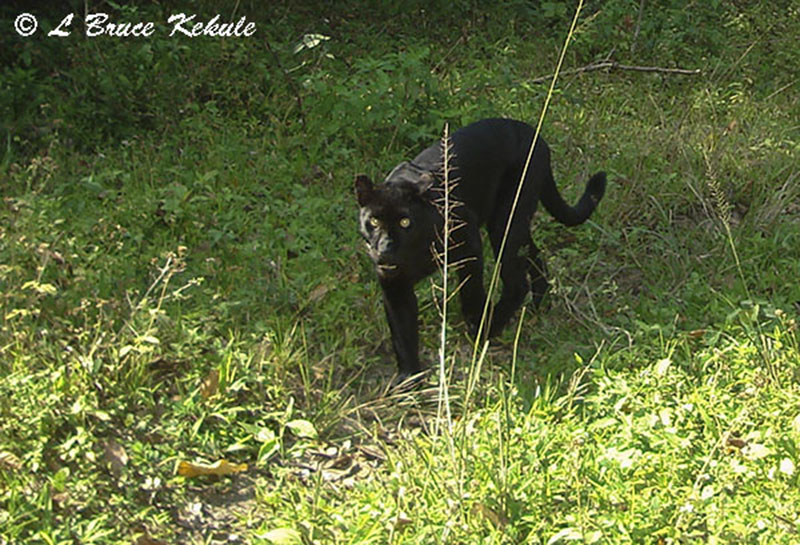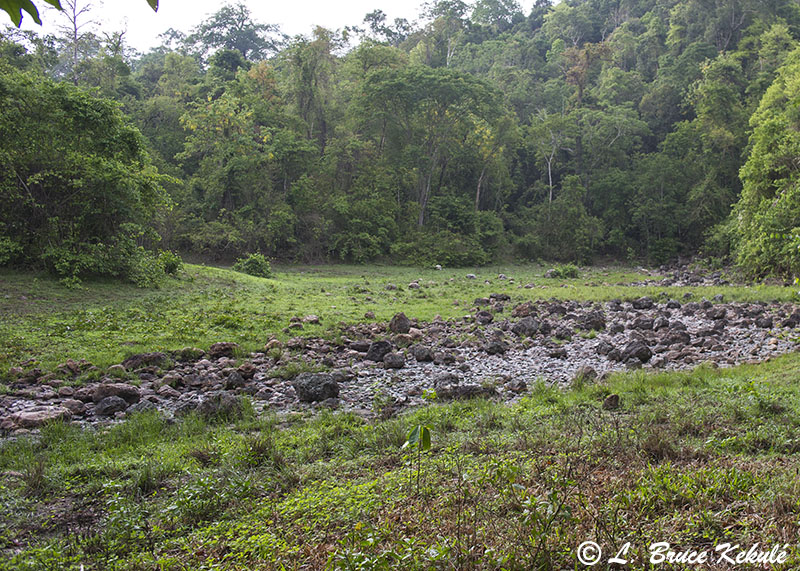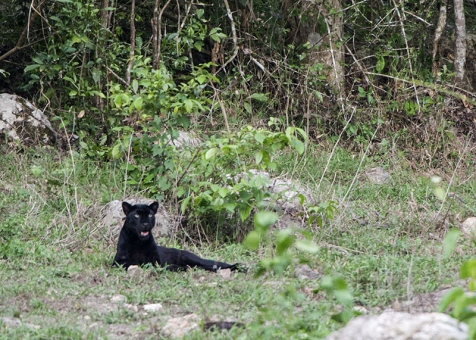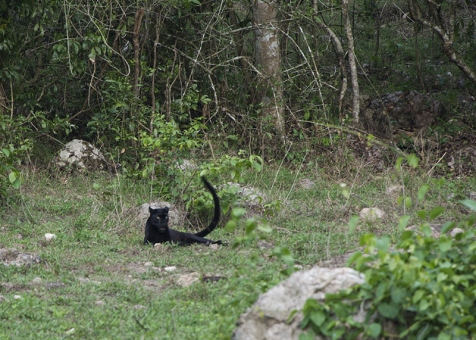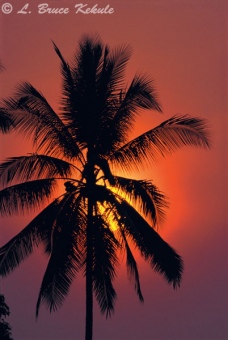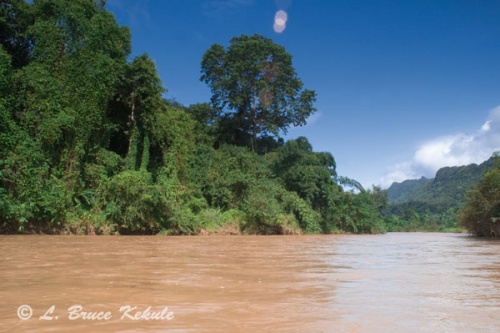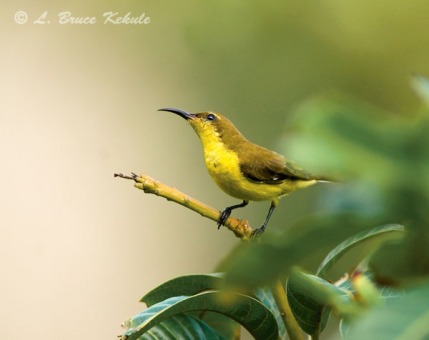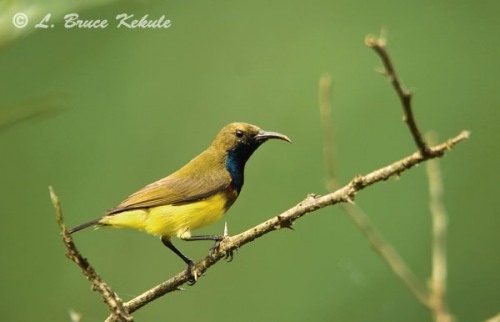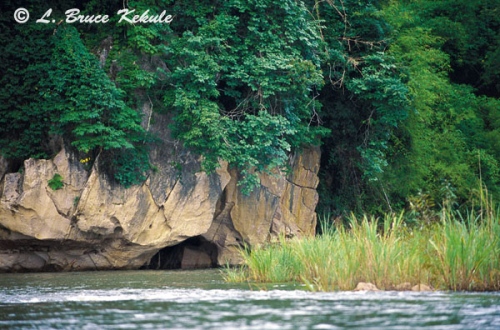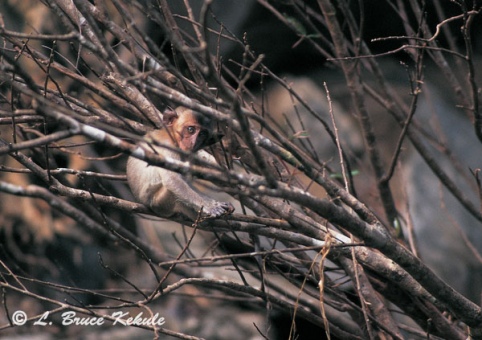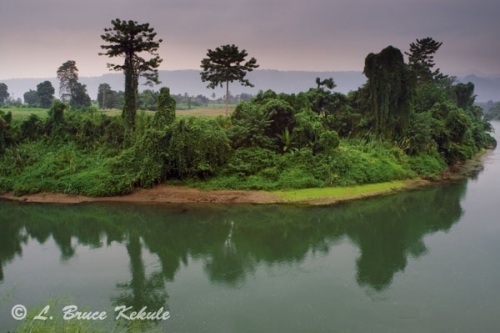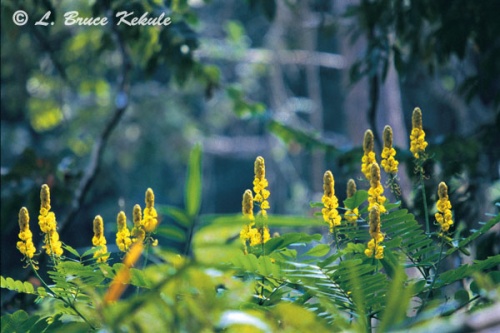Posts Tagged ‘western forest complex’
BLACK LEOPARD BLUES
My Nikon 400mm ƒ2.8 bread and butter lens fails when a black cat shows-up at a hot spring deep in the ‘Western Forest Complex’ of Thailand.
My ‘black leopard’ 16 years ago posing for the camera…!
For more than 10 years, I have used my trusty Nikon 400mm ƒ2.8 ‘Silent Wave’ lens for 90% of my ‘through the lens’ photographic work capturing many wild animals in Thailand and Africa. It has been a workhorse and the photos it produces are my best. This big telephoto lens is very heavy but is amazingly sharp and handles low-light photography extremely well.
I had no idea it was on the blink until I actually looked through the eyepiece on my camera as a ‘black leopard’ walked into the hot springs one afternoon recently. The lens would not focus and I struggled to get it going. I flipped switches and even changed out my Nikon D3s for my D300s to see if that would work. It was a hopeless feeling not being able to catch this beautiful melanistic cat going about its business in nature.
Walking into the hot springs in the afternoon showing its spots…!
In the meantime, my friend Sarawut Sawkhamkhet in the blind with me was busily clicking away as the black leopard moved about the hot spring taking in minerals. I became frustrated and sat there for a while before I rushed back to my truck (some 500 meters away) where my spare 200-400mm ƒ4 VRII lens was sitting. By the time I got back, the feline had melted back into the forest to further ruin my day.
A female black leopard leaving the hot springs in late 2013…!
Some 16 years ago, I was at this very same location but a little higher up in a tree-blind. This mineral deposit is visited by many predators and prey species alike and is one of the top wildlife photography locations in western Thailand. Large herbivores like gaur, banteng, elephant, sambar, wild pig and barking deer come here, and the big cats including tigers and leopards also come looking for something to eat and drink.
Probably the same leopard as above but camera trapped on a trail next to the blind in early 2013…!
Back then about 4:30pm, a black leopard (probably its grand-father) stepped in as the sun was sinking in the West. This creature moved across the opening in the forest and its spots glowed in the diffused light. It stayed at the springs for an hour before moving down towards me and flopping down on all fours on a fallen log posing for me. That was back in the old slide film days and I was not sure that I had got the shots until they were processed at a lab in Bangkok. The photos from that shoot many years ago are shown here and certainly illustrate how great this location really is.
An important mineral deposit/hot springs visited by many animals situated in the ‘Western Forest Complex’…!
In 2013, I was in the blind again when most likely the same leopard came in. She stayed for sometime and I got some nice shots. I also managed to get a camera trap shot shown here as she walked past the blind.
The moral of this story: Always check your camera and lens before putting it to work, and have a spare close-by in case of failure. If it’s going to happen, it will when you most likely need it as in my case.
Conclusion: Looking back, it was a valuable lesson and hopefully I will learn from it. I have gotten over it now and all I can do is just remember when I captured a beautiful black cat right here when very few images of this species were out there. And finally, there will always be another encounter down the road as these mystical cats live here and I’ll be going back…!
Sony A500 trail cam catches gaur bull
A young bull at a mineral deposit in the Western Forest Complex of Thailand
This is my first capture with the Sony A500 DSLR trail cam at this new location. Loads of wild cattle including gaur and banteng plus other large mammals like tiger and elephant come to this deposit for minerals. Unfortunately, the flashes did not go off and I have pulled the unit to change out the sensor (SSII) which has been tripping as if refresh is actuating the cam. I was lucky to get this shot as the rest of the frames are empty. I believe the chip is the old #5 hence the camera is tripping till the card is full and the flashes went dry…The 28mm lens however, seems OK for the large herbivores and carnivores at this setup.
A BIG CAT TRAILHEAD
A ‘Black Leopard’ again..!
An extraordinary sighting in Huai Kha Khaeng Wildlife Sanctuary
A black leopard resting at the hot spring.
Sometimes things happen in succession that boggles the mind. On May 6th I posted a tale about a ‘black leopard’ plus other Asian wild animals caught by my Sony S600 cam on a trail into a hot spring in Huai Kha Khaeng Wildlife Sanctuary, western Thailand where I’m currently running a camera trap program.
Entering the hot spring.
I also mentioned in the story that I photographed a ‘black leopard’ from a tree blind some 15 years ago just up the trail a bit. The ‘leopard spots’ image is one of my all-time favorite wildlife photographs ever. http://brucekekule.com/camera_trapping/a-black-leopard-passes-my-camera-trap/
Leaving the hot spring.
On May 7th, I was back at the hot springs to set camera traps, and to sit at the base of the old tree for some through-the-lens work. Who knows what might show-up.
I was with my friend Sarawut Sawkhamkhet, a Thai wildlife photographer. We arrived and set-up a temporary blind about 3pm. The weather was warm and balmy with nice clear-blue skies.
A full-frame shot.
At 5:45pm, the unthinkable happened! A ‘black leopard’ appeared out of the forest near the springs and walked over for a drink, and then disappeared for a short while. Then the magnificent creature came back and flopped down on all fours twitching its tail looking straight at us staying for about 10 minutes before going back in the forest where it had come from.
Kabook Kabieng hot springs deep in the interior.
I would venture to say, this is the same cat I camera trapped back in February and it could also be an offspring of my original leopard back in 1998. Who knows? I was elated to say the least.
To see and photograph a black leopard once again at this same location after all these years is something out of the extraordinary. When time permitted, I set one of my trusty Sony S600 cams at the hot spring and will go back in a couple of weeks to see what has visited the waterhole.
Then I intend to set a DSLR Nikon or Canon camera trap with several flashes for improved images. This place is truly worth the effort, time and difficulty to get here. I look forward to more incredible images from this wildlife haven.
The ‘Little Elephant Slider’
A 3-month old baby elephant slides in on the trail to a waterhole deep in the forests of western Thailand. This family unit is also made-up of several mature females and younger juveniles.
Sai Yok National Park: Home of the Regal Crab and Kitti’s Hog-nosed Bat
Amazing biodiversity in jeopardy made famous by the ‘Death Railway’ in World War II
On December 8, 1941, the same day of the Pearl Harbor attack in Hawaii (Dec. 7 in the U.S.), the Japanese Army invaded Thailand with thousands of troops and settled in. Sometime in 1942, a decision was made to build a railway from Bangkok to Burma and beyond through the thick malaria and tiger infested jungles in Kanchanaburi province using allied and Asian prisoners-of-war as construction labor.
Regal crab by the Mae Nam Noi river in Sai Yok National Park
Thousands died under the harsh and sometimes brutal conditions. Remnants of this rail line remain today in Sai Yok National Park. Numerous monuments to the men who lost their lives have been erected in Kanchanaburi, and the main cemetery in town is close to the rail line and the famous ‘Bridge over the River Kwai’ (Khwae).
Apart from its popular waterfalls and river trips, this national park is not that well known. Situated in Kanchanaburi province, along Thailand’s western border with Myanmar, its interior is truly a magnificent wildlife paradise encompassing exactly 500 square kilometers. However, it may not remain so for long, as poaching and forest encroachment continues to be a problem for the Department of National Parks (DNP).
Kitti’s Hog-nosed bat in a limestone cave by the Mae Nam Noi
The headquarters of the protected area is at Sai Yok Yai (big Sai Yok) waterfall, about one hundred kilometers upstream from Kanchanaburi town on the Khwae Noi River. This site is visited by scores of local and foreign tourists every year that come to see the waterfall and the smaller one at Sai Yok Noi, both of which are only a short distance off Highway 323 going north. Activities on the river include swimming, rafting, boating and picnicking.
Cave-dwelling Nectar-eating bats in a limestone cave by the Mae Nam Noi
Deep inside the park, however, one of the world’s smallest mammals, Kitti’s hog-nosed bat Craseonycteris thonglongyai discovered by the late Thai zoologist Kitti Thonglongya, is found in limestone caves along the remote Mae Nam Noi and Khwae Noi rivers. Previously, it was thought to be endemic but now this creature has been found in other isolated pockets elsewhere in Kanchanaburi, and is also thought to survive in neighboring Myanmar.
Short-nosed fruit bats
This flying mammal weighs barely two grams. Aptly, it has been called the ‘bumblebee bat’ and has an average wingspan of just three inches. It uses sonar to forage for insects during short periods each night — about 30 minutes — in the evening and again for 20 minutes just before dawn. Numbers are few and is listed by IUCN as vulnerable. At one time, this remarkable little mammal was in fact one of the world’s twelve most endangered animals. Constant foraging by locals for bat dung (guano) and catching bats with mist-nets is a serious problem that needs to be addressed.
Sunset over Sai Yok National Park
Also found in this same area is the regal crab or queen crab Thaiputsa sirikit discovered in 1983 and named in honor of Her Majesty Queen Sirikit of Thailand. This crustacean is known locally as the ‘three-colored crab’. With their white body, purple stripe down the back, and red legs, the regal crab is truly a pretty sight.
Mae Nam Choan tributary in Sai Yok
They live like most crab, in holes, which they dig along the banks of the river. They come out at night to forage for food eating mainly composted leaves. Now few in number, this is yet another species that is seriously endangered and needs complete protection.
Olive-back sunbird female by the river
Fortunately, the locals in the area have stopped eating them since they were named after the Queen. They are now protecting the few crabs that are left. This is a case of true conservation and hopefully, the species will survive into the future.
Olive-back sunbird male close by
Elephant, gaur, tiger and leopard, plus many other species, still survive in the interior of the park, but all wild animals are dwindling. Sambar, serow, muntjac, tapir and wild pig are also found and constitute the main prey species for the big cats. Asian black bear, Malayan sun bear, clouded leopard, golden cat and marble cat plus many smaller species like civet, porcupine, gibbon and monkey live here but like all the rest, they too are threatened. Birds, reptiles, insects flourish as well as plant life.
Mae Nam Noi river in Sai Yok
Like most national parks in Thailand, Sai Yok is a target for poaching and logging which seem to go hand in hand. Most of the wildlife is hunted for trophies and meat, primarily during the dry season when there is good road access. It is sometimes common to see poachers in the park, cruising along the roads in vehicles or on motorcycles. Illegal logging has been carried out along the Khwae Noi, Mae Nam Noi and Mae Nam Lo rivers. This has seriously eroded their banks.
Mae Nam Lo river in Sai Yok
Other forms of encroachment include cattle and buffalo corrals that are set up deep in the forest where fodder is easily available. The chance of ‘foot and mouth’ disease being passed on to wild ungulates is real. Fruit orchards pop up in areas along the river inhibited by wild creatures and seem to thrive. Constant illegal activities are affecting the status of the park’s wildlife and watershed integrity.
Leopard camera trapped in the interior of Sai Yok
The forests in Sai Yok are mostly tropical broad-leaved evergreen with much bamboo and mixed deciduous woodlands in the foothills. The highest peak, Khao Khewa, at 1,327 meters above sea level, is part of the Tenasserim Range that runs through the park from north to south. The area was formerly logged so the park has many thin patches where big trees were felled. However, heavy brush continues to grow back strongly in these areas.
Elephants camera trapped by the river
During the height of the rainy season, between July and October, Sai Yok’s wildlife roam and feed fairly safely due to the rough weather and almost impenetrable terrain. The rivers and streams in the park become raging torrents that make crossing them next to impossible. About the only way in is by long-tailed motorboat, with a very skilled operator.
Mae Nam Lo river deep in the interior
Many a boats and rafts has been washed away in rapids on the Mae Nam Noi and Mae Nam Lo rivers. Occasionally, 4×4 off-road vehicles become stuck in the park after heavy rains. Some have even had to wait until the dry season to get out. Elephant just love to play football with these vehicles left behind. I know a man who left his Land Rover through the rainy season and when he returned, it had been flipped over and completely smashed.
Crab-eating macaque by the Lo River
Another very important aspect of Sai Yok is that gaur and elephant come across the border from Myanmar to feed on bamboo shoots in August and September, and then return to the safety of the other side prior to the dry season. Equally interesting, there are unofficial reports of a ‘hybrid cattle’, possibly a cross between gaur and banteng that have been seen by locals.
Young crab-eating macaque with a troop
The numbers of all animals are dwindling, however, due to increased activity in the park. Just a decade ago, green peafowl were found here but they have neither been seen nor heard from for many years. The ever-shrinking wilderness area of Sai Yok is under threat that should be addressed by the DNP if its flora and fauna are to survive intact.
Mae Nam Choan river
Sai Yok has always been special to me. I basically began my career as a wildlife photographer here after making a promise to the ‘spirits of the forest’ to begin documenting Thailand’s wildlife with a camera. Some of my first photographs are the regal crab and the Kitti’s hog-nosed bat shown in the story. I also camera trapped my first and second tiger in the interior. I recently caught a leopard by camera trap along a trail by the river seen here.
Khwae Noi River in Sai Yok
The future of Sai Yok as one of Thailand’s most beautiful and important national parks depends in great measure on the DNP and their ability to enforce the law. Reportedly, greater efforts are being made by the department to protect the park and its precious wildlife and ecosystems. Some poachers and encroachers have been arrested but such campaigns can be difficult to sustain. The long-term effects will become clear over time.
Candlebra bush flowers in the interior
It is hoped this magnificent wilderness and its wildlife will survive into the foreseeable future. In particular, the home of the world’s smallest bat needs serious attention and protection. It would be a sad day for Thailand if this prestigious mammal were to be lost to extinction.





